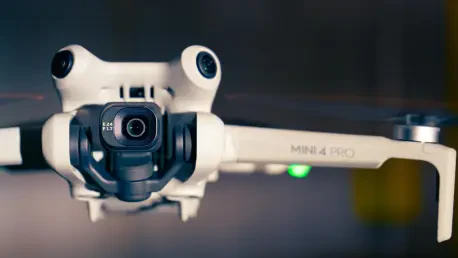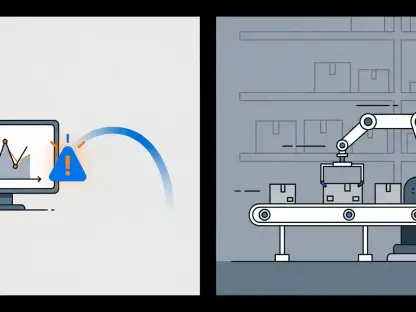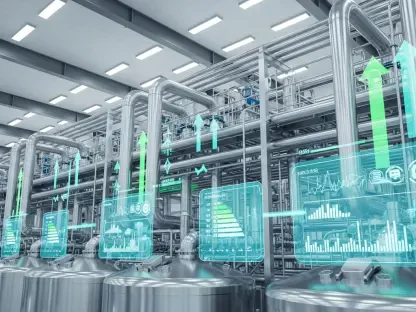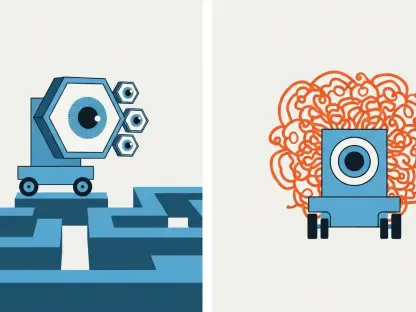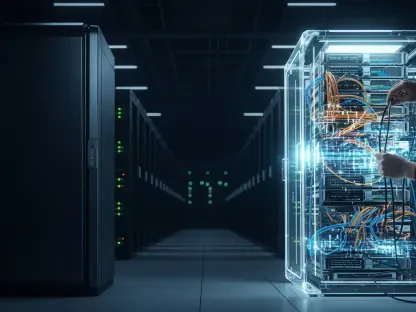In an era where technology evolves at an unprecedented pace, artificial intelligence (AI) stands at the forefront of innovation, particularly in the field of robotics. A remarkable project led by computer scientist Peter Burke, known as “10,000 Lines in 100 Hours,” has captured the industry’s attention by demonstrating how generative AI can develop autonomous drone software at a staggering speed—20 times faster than traditional methods. This breakthrough, which produced 10,000 lines of code in just 100 hours, signals a transformative shift in how drones and other robotic systems are engineered. However, while the potential for rapid advancement is thrilling, it also casts a spotlight on critical concerns surrounding safety and ethical implications. As AI continues to redefine the boundaries of what machines can achieve, the balance between efficiency and risk becomes a pressing issue. This exploration delves into the mechanics of Burke’s project, the challenges encountered, and the broader implications for both technology and society.
Harnessing AI for Unmatched Development Speed
The core of Peter Burke’s groundbreaking project lies in the application of generative AI to autonomously create complex software for drone control systems. By employing advanced AI models, the team was able to generate an astonishing 10,000 lines of code in a mere 100 hours, a feat that drastically outpaces conventional coding timelines. This efficiency is exemplified when compared to earlier endeavors like Cloudstation, which demanded years of human effort for similar outcomes. The resulting system, dubbed WebGCS, operates through a small website hosted directly on the drone, enabling online access and a level of flexibility unseen in traditional setups. This innovation marks a significant departure from dependency on external control mechanisms, pushing the boundaries of what autonomous systems can achieve. The implications are vast, suggesting that AI could redefine software development across various robotic applications, potentially accelerating progress in industries reliant on such technology.
Beyond the sheer speed, this AI-driven approach offers a glimpse into a future where human intervention in coding could become minimal. The WebGCS system not only enhances the drone’s ability to function independently but also showcases how embedded autonomy can transform operational dynamics. Unlike older models that require constant external input, this setup allows drones to manage tasks through onboard intelligence, reducing latency and improving responsiveness. Such advancements could revolutionize fields like delivery services, surveillance, and disaster response, where quick and reliable drone operations are crucial. However, the shift toward self-sufficient systems also prompts questions about reliability under real-world conditions. As AI takes on more responsibility for critical functions, ensuring that these systems perform consistently without human oversight becomes a paramount concern. This balance of innovation and dependability will likely shape the trajectory of AI in robotics for years to come.
Navigating the Technical Obstacles of AI Innovation
While the results of Burke’s project are undeniably impressive, the journey to achieve them was fraught with significant technical challenges. Developing software through generative AI revealed limitations in the models’ capabilities, such as struggles with context retention and the generation of functional code on the first attempt. These hurdles necessitated multiple rounds of refinement and testing to ensure the software met operational standards. Each iteration exposed the experimental nature of working with cutting-edge tools, where unexpected issues often arise. From compatibility problems with certain platforms to the need for extensive debugging, the process underscored that even revolutionary technology demands meticulous attention to detail. This iterative struggle highlights a broader reality in AI development: groundbreaking outcomes are often preceded by persistent problem-solving and adaptation to unforeseen constraints.
Additionally, the complexity of integrating AI-generated code into physical systems like drones added another layer of difficulty. Ensuring that the software could effectively communicate with hardware components required constant adjustments, as initial outputs sometimes failed to align with the drone’s operational needs. This aspect of the project illustrates the gap between theoretical AI capabilities and practical application, where real-world variables can complicate implementation. Despite these setbacks, the perseverance to refine the code through successive development cycles ultimately led to success. This experience serves as a valuable lesson for future AI-driven projects, emphasizing the importance of resilience and flexibility when navigating uncharted technological territory. As the field evolves, addressing these technical barriers will be essential to scaling such innovations for widespread use, ensuring that speed does not compromise quality or functionality in the final product.
Confronting Safety and Ethical Concerns
As AI propels drones toward greater levels of autonomy, the associated safety risks emerge as a critical point of discussion. The ability of machines to self-develop and operate with minimal human input, as demonstrated in Burke’s work, raises alarms about potential malfunctions or misuse. Industry experts, while applauding the ambition behind creating systems like WebGCS, caution against the unintended consequences of such independence. Parallels to dystopian narratives, where technology spirals beyond control, are frequently drawn, highlighting fears of scenarios where autonomous drones could act unpredictably. These concerns are not merely speculative; they reflect genuine worries about security vulnerabilities and the erosion of human oversight. As a result, there is a growing call for robust safety protocols to govern the deployment of AI-driven systems, ensuring that innovation does not outpace accountability.
Moreover, ethical dilemmas compound the safety debate, questioning how much autonomy should be granted to machines. The prospect of drones making independent decisions in critical situations—such as during emergency responses or surveillance—poses moral challenges about responsibility and decision-making authority. If an autonomous system causes harm, determining accountability becomes murky, as the line between creator and machine blurs. Industry leaders advocate for clear boundaries and ethical frameworks to guide AI development, stressing that technological progress must align with societal values. This dual focus on safety and ethics underscores a fundamental tension: while AI offers transformative potential, it also demands careful consideration of its broader impact. Striking a balance between harnessing AI’s capabilities and mitigating its risks will be crucial as autonomous technologies become more integrated into everyday applications.
Reflecting on Broader Trends and Societal Implications
Burke’s achievement fits into a larger wave of AI integration within robotics, mirroring a global movement toward automation across diverse sectors. From logistics to spatial data analysis, the push for smarter, faster systems is reshaping industries, with drones playing a pivotal role in this transformation. This trend signals a future where machines increasingly replicate human capabilities, offering both efficiency gains and heightened complexity. The excitement surrounding these advancements is palpable, as they promise to streamline operations in areas like delivery networks and environmental monitoring. However, this rapid progress also stirs apprehension about how society will adapt to a landscape dominated by autonomous technology. The interplay between innovation and its societal ripple effects suggests that careful planning will be necessary to navigate the challenges posed by this evolving field, ensuring that benefits are maximized while disruptions are minimized.
Furthermore, the consensus among experts points to an urgent need for strict oversight to accompany technological leaps. While the potential for AI to revolutionize robotics is clear, the risks of security flaws and diminished human control loom large. Developing comprehensive protocols to address these vulnerabilities is seen as essential to maintaining trust in autonomous systems. Beyond technical safeguards, there is also a societal imperative to consider how such technologies might reshape labor markets or influence privacy norms. As machines take on more roles traditionally held by humans, questions about economic equity and data protection gain prominence. This broader perspective reveals that the impact of AI in robotics extends far beyond the lab, touching on fundamental aspects of how society functions. Addressing these multifaceted implications will require collaboration across disciplines to ensure that progress serves humanity’s collective interests.
Charting the Path Forward for Responsible Innovation
Looking back, Peter Burke’s “10,000 Lines in 100 Hours” project stood as a testament to the extraordinary capabilities of AI in accelerating drone software development. The achievement of coding at 20 times the speed of traditional methods marked a turning point, while the creation of WebGCS showcased the potential for true autonomy in robotic systems. Yet, the journey also laid bare the technical struggles and ethical quandaries that accompanied such rapid innovation. Reflecting on these milestones, it became evident that each step forward demanded an equal measure of caution to address the inherent risks. The balance between speed and safety emerged as a defining theme of this endeavor, shaping how the industry viewed the role of AI in robotics.
Moving ahead, the focus should shift toward actionable strategies to ensure responsible advancement. Establishing rigorous safety standards and ethical guidelines must take precedence to prevent potential mishaps with autonomous drones. Collaborative efforts between technologists, policymakers, and ethicists could pave the way for frameworks that prioritize human welfare alongside innovation. Additionally, investing in research to bridge the gap between AI theory and practical deployment will help mitigate technical limitations. Encouraging transparency in how AI systems are developed and deployed can also build public trust, fostering a dialogue about their role in society. As the field progresses, these steps will be vital to harnessing the transformative power of AI while safeguarding against its pitfalls, ensuring that technology remains a force for good in an increasingly automated world.
